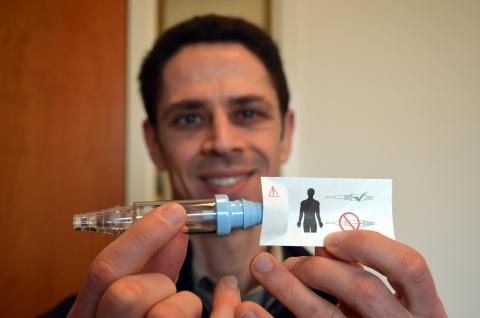
Photo: Josh Broder, MD, holds up a "Heimlich valve" and its updated labeling. Broder helped identify aesthetic challenges with the piece.
In the fast-paced setting of health care, being aware of how actions impact patient safety is key. And as one Duke doctor has found out, that applies just as much to the equipment they use.
Josh Broder, MD, an emergency medicine specialist at Duke University Hospital, has been leading the charge for some labeling updates to specific pieces of medical equipment.
It began in 2015, when he noticed an issue with a “Heimlich valve,” which creates a one-way path for air to flow out of a patient’s chest after suffering a collapsed lung. Labeling on the plastic piece wasn’t easily detectable and the symmetrical tube could easily be attached in the wrong direction.
“Not only would it not allow treatment to occur, but it could worsen the patient’s condition by trapping air inside the chest,” he said.
Hear Dr. Broder explain why and how it matters in the video above.
After doing an analysis and publishing research in the Emergency Medicine Journal, Broder worked with the manufacturer to make changes including a paper label to show which side needed to be attached to a patient. The updated equipment is now in circulation.
Broder recently turned his attention to another piece of equipment known as a “pigtail catheter.” That piece is inserted into the chest and is constructed in a way that if an internal pipe isn’t removed, could obstruct airflow. The removable piece could be better labeled or constructed to avoid this error, Broder said, so he’s again working to try and update the equipment for safety.
“The only way we can make the system better and protect our patients is to recognize errors and work to change the system,” he said. “It’s our duty to act in ways to protect our patients.”
